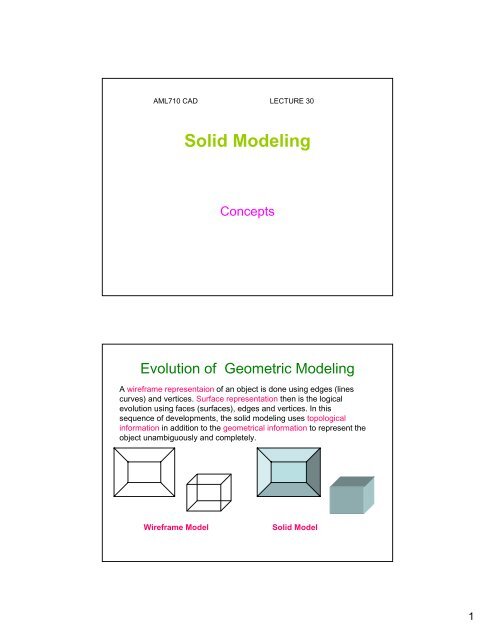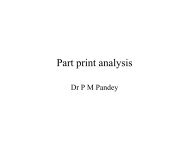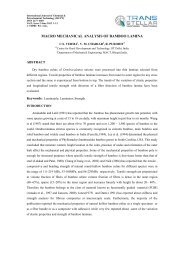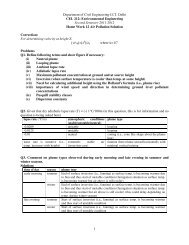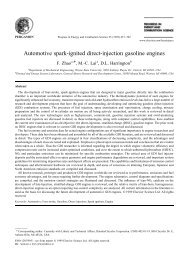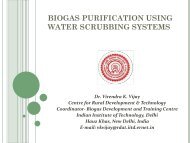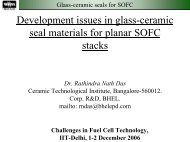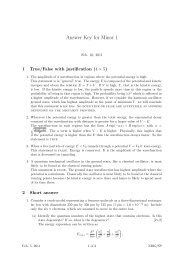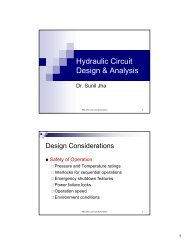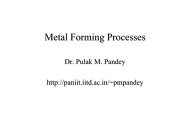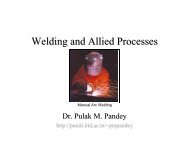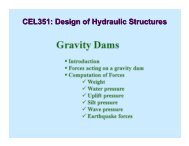Solid Modeling
Solid Modeling
Solid Modeling
Create successful ePaper yourself
Turn your PDF publications into a flip-book with our unique Google optimized e-Paper software.
AML710 CAD LECTURE 30<br />
<strong>Solid</strong> <strong>Modeling</strong><br />
Concepts<br />
Evolution of Geometric <strong>Modeling</strong><br />
A wireframe representaion of an object is done using edges (lines<br />
curves) and vertices. Surface representation then is the logical<br />
evolution using faces (surfaces), edges and vertices. In this<br />
sequence of developments, the solid modeling uses topological<br />
information in addition to the geometrical information to represent the<br />
object unambiguously and completely.<br />
Wireframe Model<br />
<strong>Solid</strong> Model<br />
1
Advantages of <strong>Solid</strong> Models<br />
Unlike wireframes and surface representations which contain only<br />
geometrical data, the solid model uses topological information in<br />
addition to the geometrical information to represent the object<br />
unambiguously and completely. <strong>Solid</strong> model results in accurate<br />
design, helps to further the goal of CAD/ CAM like CIM, Flexible<br />
manufacturing leading to better automation of the manufacturing<br />
process.<br />
Geometry: The graphical information of dimension, length, angle,<br />
area and transformations<br />
Topology: The invisible information about the connectivity,<br />
neighborhood, associatively etc<br />
Is a solid model just a shaded image?<br />
Three dimensional addressability?<br />
Suitable for automation?<br />
Wireframe Model <strong>Solid</strong> Model<br />
Geometry:<br />
Geometry Vs Topology<br />
Metrics and dimensions of the solid object. Location of the object in a<br />
chosen coordinate system<br />
Topology:<br />
Combinatorial information like connectivity, associativity and neighborhood<br />
information. Invisible relationship information.<br />
L 2<br />
L 1<br />
P 1<br />
L 3<br />
R 1<br />
L 2<br />
L 1<br />
R 1<br />
L 3<br />
P 1<br />
Same geometry and different Topology<br />
2
Manifold Vs Non-manifold<br />
Two Manifold Representations:<br />
Two manifold objects are well bound, closed and homomorphic to a<br />
topological ball.<br />
Non-manifold Representations:<br />
When restrictions of closure and completeness are removed from the solid<br />
definition, wireframe entities can coexist with volume based solids.<br />
Dangling<br />
face<br />
Two-Manifold Object<br />
Dangling<br />
edge<br />
Non-Manifold<br />
Representation<br />
Disadvantages of Wireframe Models<br />
• Ambiguity<br />
• Subjective human interpretation<br />
• Complex objects with many edges<br />
become confusing<br />
• Lengthy and verbose to define<br />
• Not possible to calculate Volume<br />
and Mass properties, NC tool<br />
path, cross sectioning etc<br />
3
Definition of a <strong>Solid</strong> Model<br />
A solid model of an object is a more complete representation than its<br />
surface (wireframe) model. It provides more topological information<br />
in addition to the geometrical information which helps to represent<br />
the solid unambiguously.<br />
Wireframe Model<br />
<strong>Solid</strong> Model<br />
History of Geometric <strong>Modeling</strong><br />
Year<br />
1972<br />
1973<br />
1973<br />
Modeler<br />
PAP, PADL-I,<br />
PADL2<br />
Build-I<br />
Build-II<br />
TIPS-I<br />
Developer<br />
Univ. of Rochester, Voelcker & Requicha<br />
Braid’s CAD Group in<br />
Cambridge, UK<br />
Hokkaido University, Japan<br />
1975<br />
GLIDE-I<br />
Eastman’s Group in CMU, USA<br />
1975<br />
1981<br />
Euler Ops<br />
Winged Edge,<br />
B-rep<br />
Romulus<br />
Baumgart, Stanford Univ., USA<br />
Evans and Sutherland, 1 st commercial<br />
4
Geometric <strong>Modeling</strong> - Primitives<br />
Primitives and Instances<br />
PRIMITIVES<br />
INSTANCES<br />
Instancing: An instance is a scaled<br />
/ transformed replica of its original.<br />
The scaling may be uniform or<br />
differential. It is a method of<br />
keeping primitives in their basic<br />
minimum condition like unit cube<br />
and unit sphere etc.<br />
5
<strong>Solid</strong> Primitives: Ready starting objects<br />
Y<br />
Y<br />
L<br />
Z<br />
P<br />
B<br />
Y<br />
H<br />
D<br />
X<br />
BLOCK<br />
R<br />
Z<br />
CYLINDER<br />
Y<br />
X<br />
WEDGE<br />
SPHERE<br />
Z<br />
H<br />
P<br />
B<br />
D<br />
X<br />
Z<br />
R<br />
X<br />
Origin of MCS: P Orientation Topology and shape<br />
Dimension (size) L,B,H.D,R Perspective on/off<br />
<strong>Solid</strong> Primitives: Ready starting objects<br />
Y<br />
Y<br />
TORUS<br />
X<br />
Z<br />
P<br />
R<br />
X<br />
H<br />
CONE<br />
R i<br />
R o<br />
Z<br />
R<br />
PERSPECTIVE OFF<br />
PERSPECTIVE ON<br />
6
Operation on Primitives<br />
• A desired solid can be obtained by combining two or more solids<br />
• When we use Boolean (set) operations the validity of the third<br />
(rusulting) solid is ensured<br />
A<br />
A<br />
B<br />
B<br />
3 Dimensional<br />
UNION: BLOCK ∪ CYLINDER<br />
A ∪B<br />
Operation on Primitives<br />
• A desired solid can be obtained by combining two or more solids<br />
• When we use Boolean (set) operations the validity of the third<br />
(rusulting) solid is ensured<br />
A<br />
A<br />
B<br />
B<br />
UNION: BLOCK ∪ CYLINDER<br />
A ∪B<br />
7
Operation on Primitives<br />
A<br />
A<br />
A<br />
B<br />
B<br />
A-B<br />
B<br />
INTERSECTION:<br />
BLOCK ∩ CYLINDER<br />
A ∩ B<br />
B-A<br />
DIFFERENCE:<br />
BLOCK - CYLINDER<br />
Simple Polyhedron – Euler’s Formula<br />
• Euler’s formula gives the relation<br />
amongst faces, edges and vertices of a<br />
simple polyhedron.<br />
• V-E+F=2. This formula tells us that<br />
there are only 5 regular polyhedra<br />
• Consider polyhedra with every face<br />
having h edges, k edges emanating<br />
from each vertex and each edge<br />
sharing exactly 2 faces, then we can<br />
write an invariant for the solid as:<br />
• hF=2E=kV Substituting this in Euler’s<br />
formula we get<br />
2E<br />
2E<br />
− E +<br />
k h<br />
= 2 ⇒<br />
1<br />
E<br />
1 1 1<br />
= + −<br />
h k 2<br />
8
Five Regular Polyhedra<br />
2E<br />
2E<br />
− E + = 2<br />
k h<br />
⇒<br />
1 1 1 1<br />
0 < = + −<br />
E h k 2<br />
• We notice that for a polyhedron h,k≥3<br />
• What happens if h=k=4 ?<br />
• If we take h=3, then 3≥k≥5<br />
• Then by symmetry, if k=3 then 3≥h≥5<br />
• Thus the possible polyhedra can be symbolically given as:<br />
(h,k,E)=(3,3,6), (3, 4, 12), (4,3,12), (5, 3, 30) and (3, 5, 30);<br />
tetrahedron, octahedron, cube, dodecahedron, icosahedron<br />
<strong>Solid</strong> Representation<br />
• The solid representation of an object is based on the<br />
idea that a physical object divides an n-dimensional<br />
space E n into two regions: interior and exterior<br />
separated by the object boundaries (two-manifold<br />
objects)<br />
• From this point of view any solid model is defined<br />
mathematically as a point set S in the three dimensional<br />
Euclidean space E 3<br />
S = iS U bS<br />
where iS is the interior point set and bS the boundary set.<br />
The universal set is now defined as<br />
W = iS U bS U cS<br />
Where cS is the complementary set of iS U bS<br />
9
Interior, Exterior and Closure<br />
• The following example will illustrate the concepts<br />
of interior, boundary, closure and exterior.<br />
• Consider a unit sphere<br />
• It’s interior is<br />
• Its Boundary is<br />
• <strong>Solid</strong> sphere is<br />
Its closure<br />
x<br />
x<br />
x<br />
2<br />
2<br />
2<br />
+ y<br />
+ y<br />
+ y<br />
2<br />
2<br />
2<br />
+ z<br />
+ z<br />
+ z<br />
2<br />
2<br />
2<br />
< 1<br />
= 1<br />
≤1<br />
• Whatever is outside of this closure is exterior<br />
Geometric Closure<br />
• The universal set is now defined as<br />
W = iS U bS U cS<br />
where cS is the complementary set of iS U bS<br />
• The interior of the solid is geometrically closed by its<br />
boundaries<br />
S = kS = iS U bS<br />
cS<br />
W⇒ E 3<br />
iS U bS =<br />
S<br />
S<br />
•Wireframe models lack closure propery<br />
•Curve in E 3 is one dimensional in parametric<br />
space<br />
•A surface in E 3 is two dimensional in<br />
parametric space<br />
10
Properties of <strong>Solid</strong> Models<br />
• Rigidity: Shape of the solid is invariant w.r.t<br />
location/orientation<br />
• Homogeneous 3-dimensionality: The solid<br />
boundaries must be in contact with the interior.<br />
No isolated and dangling edges are permitted.<br />
Dangling<br />
face<br />
≠<br />
=<br />
Dangling<br />
edge<br />
Non-Manifold<br />
Representation<br />
Properties of <strong>Solid</strong> Models<br />
• Finiteness and finite describability: Size is<br />
finite and a finite amount of information can<br />
describe the solid model.<br />
• Closure under rigid motion and regularised<br />
Boolean operations: Movement and Boolean<br />
operations should produce other valid solids.<br />
• Boundary determinism: The boundary must<br />
contain the solid and hence determine the solid<br />
distinctly.<br />
• Any valid solid must be bounded, closed,<br />
regular and semi-analytic subsets of E 3<br />
11
Properties of <strong>Solid</strong> Models<br />
• The regularized point sets which represent<br />
the resulting solids from Boolean<br />
operations are called r-sets (regularized<br />
sets.<br />
• R-sets can be imagined as curved<br />
polyhedra with well behaved boundaries.<br />
Properties of <strong>Solid</strong> <strong>Modeling</strong> Schemes<br />
The schemes operate on r-sets or point sets to produce the<br />
desired solid model, which is automatically a valid solid<br />
• For unambiguous, complete and unique representation the<br />
scheme maps points form point set (Euclidian) into a valid<br />
model to represent the physical object.<br />
Unlimited Point set , W Model space , S<br />
Representation<br />
Scheme<br />
UCU O Unambiguous,<br />
complete, unique<br />
P<br />
UCN<br />
O P 1<br />
P 2<br />
O 1 O 2<br />
P<br />
Unambiguous,<br />
complete, non-unique<br />
AIN<br />
Ambiguous,<br />
incomplete, non-unique<br />
12
Common Features of <strong>Modeling</strong> Schemes<br />
• Domain: The type of objects that can be represented or the<br />
geometric coverage.<br />
• Validity: The resulting solid model when subjected to<br />
algorithms should succeed as valid solid.<br />
• Completeness and Unambiguousness.<br />
• Uniqueness: Positional and Permutational uniqueness.<br />
a<br />
b<br />
b<br />
a<br />
S=A U B U C<br />
A C<br />
B<br />
S=C U B U A<br />
C A<br />
B<br />
Positionally non-unique<br />
Permutationally non-unique<br />
Desirable Properties of <strong>Modeling</strong><br />
Schemes<br />
• Conciseness, ease of creation and efficiency in<br />
application.<br />
• Conciseness means compact database to<br />
represent the object.<br />
• Ease of operation implies user-friendliness.<br />
Most of the packages use CSG approach to<br />
create the solids<br />
• The representation must be usable for later<br />
operations like CAM / CNS etc<br />
13
Classification of <strong>Solid</strong> <strong>Modeling</strong><br />
• Boundary based or Volume based<br />
• Object based or spatially based<br />
• Evaluated or unevaluated<br />
Boundary |<br />
Volume<br />
Unevaluated<br />
Spatial<br />
Object<br />
Half space<br />
Euler Ops<br />
Octree<br />
CSG<br />
Unevaluated<br />
Evaluated<br />
Boundary<br />
based<br />
Volume<br />
Based<br />
Object<br />
based<br />
Spatial<br />
based<br />
Evaluated<br />
Spatial<br />
Object<br />
Boundary<br />
Cell Enum<br />
Boundary<br />
Rep<br />
Cell Enum<br />
Nonparametic<br />
Major <strong>Modeling</strong> Schemes<br />
1. Half Spaces.<br />
2. Boundary Representation (B-Rep)<br />
3. Constructive <strong>Solid</strong> Geometry (CSG)<br />
4. Sweeping<br />
5. Analytical <strong>Solid</strong> <strong>Modeling</strong> (ASM)<br />
6. Cell decomposition<br />
7. Spatial Ennumeration<br />
8. Octree encoding<br />
9. Primitive Instancing<br />
• The 3 most popular schemes: B-rep, CSG,Sweeping<br />
14
Conversion Among Representations<br />
Some representations can be converted to other<br />
representations.<br />
• CSG to B-REP (but not B-rep to CSG)<br />
B-Rep<br />
2. Sweep CSG<br />
Cell Decomposition<br />
Some <strong>Solid</strong> Modelers in Practice<br />
Modeler<br />
Developer<br />
Primary<br />
Scheme<br />
User Input<br />
CATIA<br />
IBM<br />
CSG<br />
BREP+CSG<br />
GEOMOD /<br />
I-DEAS<br />
SDRC/EDS<br />
BREP<br />
BREP+CSG<br />
PATRAN-G<br />
PDA ENGG.<br />
ASM<br />
HYPERPATCHES+CSG<br />
PADL-2<br />
CORNELL UNI.<br />
CSG<br />
CSG<br />
SOLIDESIGN<br />
UNISOLIDS /<br />
UNIGRAPHICS<br />
PRO-E<br />
COMPUTER<br />
VISION<br />
McDONELL<br />
DOUGLAS<br />
PARAMETRIC<br />
BREP<br />
CSG<br />
BREP<br />
BREP+CSG<br />
BREP+CSG<br />
BREP+CSG<br />
SOL. MOD. SYS<br />
INTERGRAPH<br />
BREP<br />
BREP+CSG<br />
15
Algorithms in <strong>Solid</strong> Modelers<br />
• Three types of algorithms are in use in many<br />
solid modelers according to the kind of input<br />
and output<br />
1. a; data -> representation<br />
Data<br />
Representation<br />
Algorithm<br />
most common – build, maintain, manage<br />
representations<br />
Algorithms in <strong>Solid</strong> Modelers<br />
• Some algorithms operate on existing models to<br />
produce data.<br />
2. a; representation -> data<br />
Representation<br />
Algorithm<br />
Data<br />
E.g.. Mass property calculation<br />
16
Algorithms in <strong>Solid</strong> Modelers<br />
• Some representations use the available<br />
representations to produce another<br />
representation.<br />
3. a: representation -> representation<br />
Representation<br />
Representation<br />
Algorithm<br />
• E.g. Conversion from CSG to B-rep<br />
Closure and Regularized set<br />
Operations<br />
• The interior of the solid is geometrically closed by its<br />
boundaries<br />
S = kiS = iS U bS<br />
iS U bS =<br />
S<br />
•If the closure of the interior of a given set yields that same<br />
given set then the set is regular<br />
•Mathematically a given set is regular if and only if:<br />
S = kiS = iS U bS<br />
P ∪*<br />
Q = ki(<br />
P ∪Q);<br />
P −*<br />
Q = ki(<br />
P − Q);<br />
P ∩*<br />
Q = ki(<br />
P ∩Q)<br />
c*<br />
Q = ki(<br />
cQ)<br />
17
Regularized set Operations<br />
• The interior of the solid is geometrically closed by its<br />
boundaries<br />
A ∪*B<br />
A<br />
B<br />
A −*B<br />
A ∩*<br />
B = ϕ<br />
A<br />
Set Membership Classification<br />
• The process by which various parts of a candidate set X<br />
(points, lines or solids) are assigned to (is tested) with a<br />
reference set iS, bS or cS is called set membership<br />
classification.<br />
M [ X , S]<br />
= ( X in S,<br />
X on S,<br />
X out S)<br />
• X – the candidate set<br />
• S – reference set<br />
1<br />
2<br />
3<br />
4<br />
S<br />
Input<br />
Arguments<br />
6<br />
5<br />
Line<br />
Segment<br />
1<br />
2<br />
3<br />
4<br />
5<br />
6<br />
Test Result<br />
L out S<br />
L in S<br />
L out S<br />
L in S<br />
L on S<br />
L out S<br />
18


